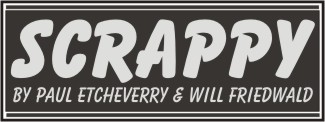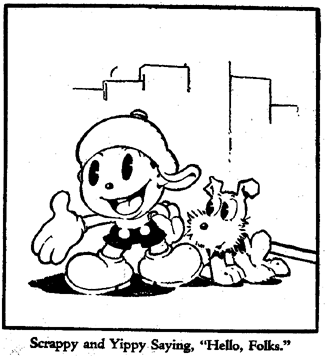
Reprinted from Animania #20, February 1981
and Animania #21, June 1981
Cartoons added in January 2022

(2005 Editor’s Notes: The article you are about to read was originally published in two parts in Dave and Kathy Mruz’s classic animation fanzine Animania (formerly, and more fondly, known as Mindrot) more than two decades ago. It was one of the first pieces of Scrappy scholarship, and it may still be the most important one–which is why we’re so happy to republish it here.
As a filmography, this work is incomplete; it’s missing full information on a bunch of shorts. But it’s the only place we know where so much has been written so entertainingly about so many Scrappy films. (The Big Cartoon Database contains data about more shorts, but has scant information on specific cartoons. Its description of the series–“The adventures of a young boy and his dog. Vonsey and Oopie are the two bullies on the block who sometime give the two problems”–makes you wonder if anyone involved with its research has ever seen a Scrappy cartoon. And it inexplicably credits Chuck Jones with story work on the series.)
We’ve digitized this piece but haven’t tried to update or expand it; other than a few typo corrections (and probably a few new glitches), what you see here is exactly what was originally published. The illustrations, like much of the art on this site, come from a 1934 Big Little Book.
Many thanks to Paul Etcheverry and Will Friedwald for their gracious permission to republish this article after so many years.)
(2022 Editor’s Addendum: This filmography now includes embedded versions of almost every Scrappy cartoon, as well as information on one Scrappy cartoon that was missing: 1940’s Fish Follies.)
Scroll onward to read the original introduction, or click below to go directly to a filmography section:
1931-1932
1933-1934
1935-1936
1937-1938
1939-1941
Introduction by Paul Etcheverry
The Mintz/Columbia SCRAPPY cartoons present something of an enigma. The films’ key contributors later achieved considerable success with Disney, Warners, and other studios. Scrappy’s most entertaining adventures are unique and highly inventive. But the series, conspicuously absent from latter day retrospectives of 1930’s animation, shares the dubious distinction of being among the most obscure short subjects of all time. The paradox suggests that the Scrappy cartoons, after all these years, could stand a second look.
There are reasons for the scarcity of these films. Once Hanna-Barbera’s color (made for TV) cartoons became, on their first rerun, widely circulated to independent stations, black and white cartoons began to disappear from television distribution. More rationale lies in the series’ style and character. Its stars, two exceedingly cartoony little boys, Scrappy and Oopy (or Vontzy), have a “Punch and Judy” relationship which, to some audiences, may not be terribly appealing. Many titles have non-linear or nonexistent narratives. The pre-1936 efforts match child characters with scenarios notable for heinous villains, outlandish situations, strange camera compositions, surreal dreamlands and bizarre shock gags. After 1935, the films become less doggedly unusual, but wildly inconsistent. It all adds up to a series being overlooked.
Perhaps these cartoons’ strengths have been overshadowed by the fact that Scrappy and Oopy, despite their peculiar, oddball charm, are less sympathetic than most enduringly popular cartoon characters. To save his pet, Yippy, from the confines of a dog pound (which looks more like San Quentin) in THE DOG SNATCHER, Scrappy rips the skin off a guard dog, hides in it, and barks. THE PUPPET MURDER CASE has Scrappy beating his brother for trying to sneak into his puppet show without paying; when Oopy retaliates by severing the performers’ strings, Scrappy subjects him to a bizarre trial by marionette. In LET’S RING DOORBELLS, the little monsters torment an obese man; later, the worm turns, when they undergo a series of nightmarish experiences in the mansion of a madman. The opening of DIZZY DUCKS shows our heroes, this time would-be duck hunters, firing at everything in sight with ridiculously huge rifles, making cataclysmic ear-shattering explosions. These four films offer a great deal in terms of animation, background art, cinematic techniques and creative gags. However, viewers who require lovable characters to identify with will undoubtedly be disappointed, and possibly offended. Scrappy and Oopy are not harmless dolts (Goofy), engaging loonies (Daffy Duck) or charming con artists (Bugs Bunny), but compulsively mischievous kids.
The moviegoer in search of sunny cartoons with endearing stars will be even more dismayed by the series’ roster of hideous bad guys and oddball featured players. The gallery of Scrappy’s adversaries includes the bullies of initial episodes (YELP WANTED, SUNDAY CLOTHES); a cross between wolf, aardvark and hairy wild pig in THE WOLF AT THE DOOR; demnented robots in TECHNORACKET; an ogre who, in SANDMAN TALES, kidnaps Oopy; the mad scientist and futuristic monster of TME GREAT EXPERIMENT; SCRAPPY’S GHOST STORY’s brigade of ghoulish sorts; a needle-nosed Loony with a five toot beard in LET’S RING DOORBELLS; cruel dog catchers in THE DOG SNATCHER and CANINE CAPERS. Even incidental characters are, to say the least, exotic. Unnamed wise guys-prankster fish, brash bugs, impudent birds, SASSY CATS-who generally make life miserable for Scrappy and Oopy (in THE PET SHOP, a whole store full of nasty beasts declares open season on them) populate the early Scrappies. The dwarfs in SANDMAN TALES and the merry Martians of SCRAPPY’S TRIP TO MARS are aliens in the pure sense of the word. Hilariously seedy animal degenerates patronize Scrappy’s cheap space in THE FLOP HOUSE, perhaps the ultimate Depression era cartoon. The celebrity caricature entries-SCRAPPY’S PARTY, THE WORLD’S AFFAIR, MOVIE STRUCK among them-permit the powers of exaggeration to run rampant, with extremely funny results. Of their contemporaries, only the pre-1935 Fleischer cartoons consistently outdo this series for unique, off-the-wall character designs.
Scrappy cartoons, whether great, amusing, mediocre, or just plain bad, share a freewheeling approach to story. Some early episodes-YELP WANTED, SUNDAY CLOTHES, THE LITTLE PEST, THE DOG SNATCHER, SHOWING OFF, BATTLE OF THE BARN-loosely construct as many gags as possible on a simple childhood conflict. Others (TREASURE RUNT, RAILROAD WRETCH, THE PET SHOP, THE FLOP HOUSE, THE WOLF AT THE DOOR) place Scrappy and Oopy nominally in charge of situations normally reserved for adults; comic ideas appear to be improvised on the premise. A batch of 1933-34 efforts-SCRAPPY’S PARTY, WORLD’S AFFAIR, MOVIE STRUCK, HOLLYWOOD BABIES, SCRAPPY’S AUTO SHOW and SCRAPPY’S EXPEDITION, to name a few-revolve around music and colebrity caricatures. It’s difficult not to be swept up in the bouyant spirit of these cartoons, even though they don’t have much in the way of plot. Later, the, “it’s all been a dream” format finds frequent use. At times, as in THE GREAT EXPERIMENT, GOLD GETTERS, and DIZZY DUCKS, it exists to arbitrarily end the picture, or tie up unrelated sequences. LET’S RING DOORBELLS and SCRAPPY’S GHOST STORY do not close with the boys waking from a nightmare, but rely on surreal imagery just the same. Such films as HOLIDAY LAND, SCRAPPY’S TRIP TO MARS, and the incredible SANDMAN TALES, in which Scrappy and Oopy journey to an ecstatic, Maxfield Parrish-like fairyland, portray the illusion so convincingly that the absence of structured narrative, pathos or sentiment is the farthest thing from one’s mind. Since so many Mintz cartoons are either all gags, or resolutely non-linear, the secret of lasting popularity eluded them: easy accessibility.
The early Scrappies do have one principal strength: a crazy, anarchic humor style. There’s the bewildering shot in TECHNORACKET with about a dozen crazed robots running wild at Scrappy’s farm, The Albert Einstein caricature in SCRAPPY’S PARTY pulls a full-sized telephone out of his hair. A hound chases a cat in. THE PET SHOP and destroys absolutely everything in his path. In THE FALSE ALARM, fireman Scrappy hitches the wrong end of the horse to his wagon, so he simply rips the beast’s head out and plants it in the other end; in a priceless moment, after Scrappy orders everyone in front of the fire station to stand back and make way for them to race to a fire, this horse emerges, pulling the wagon in the slowest, moat lethargic manner imaginable. When Scrappy opens the door to his home in SASSY CATS, a feline whistles, and the next shot shows hundreds of cats invading from all directions. The boys enter their homemade vehicle in SCRAPPY’S AUTO SHOW by crashing a new model off the center stage. These are just a few examples of the humor in the pre-1934 endeavors, which comprises some of the wackiest of pre-Tex Avery sight gags.
Several of the most explosively funny sequences derive from Oopy’s diminutive size and prowess as a one kid disaster area. He hides on the end of Scrappy’s fishing pole in THE LITTLE PEST, and is taunted by miniscule fish in TREASURE RUNT. The little kid dons an icebag atop his head and holds a butterfly net as he trudges out into the frozen North to battle a vicious brute in THE WOLF AT THE DOOR. The “topper” of MINDING THE BABY shows Oopy holding a full fishbowl, swinging upside down from a cuckoo clock and tossing the fish back and forth. In MOVIE STRUCK, he cleans a floor by tearing out floorboards, soaping them and forcing them through a ringer; at another point he carries a ceiling-high stack of dishes to a sink only to have them picked off, one by one, by a rotating fan. A memorable scene from THE FLOP HOUSE, with Oopy, as he prepares for bed, slamming his shoe loudly on the floor, smashing a window, breaking a glass and crushing an alarm clock, much to the consternation of all there, really epitomizes this character.
Though the series admittedly had its low points (mostly in the late 30’s, once they, with the Mintz KRAZY KATS, had taken back seat to the COLOR RHAPSODIES in budgets, care, style, etc.), they deserve a better fate than the refuse bin, where countless worthwhile short films have been relegated. In the run of early 30’s cartoons, the Scrappies, for sheer laughs, are only surpassed by the best of Disney and Fleischer. The cream of the mid-30’s efforts (SCRAPPY’S GHOST STORY, SCRAPPY’S BIG MOMENT, DIZZY DUCKS and the last halves of LET’S RING DOORBELLS and THE PUPPET MURDER CASE) use the language of animation and film to create worlds that can only be found onscreen–which is what animation is all about. `
